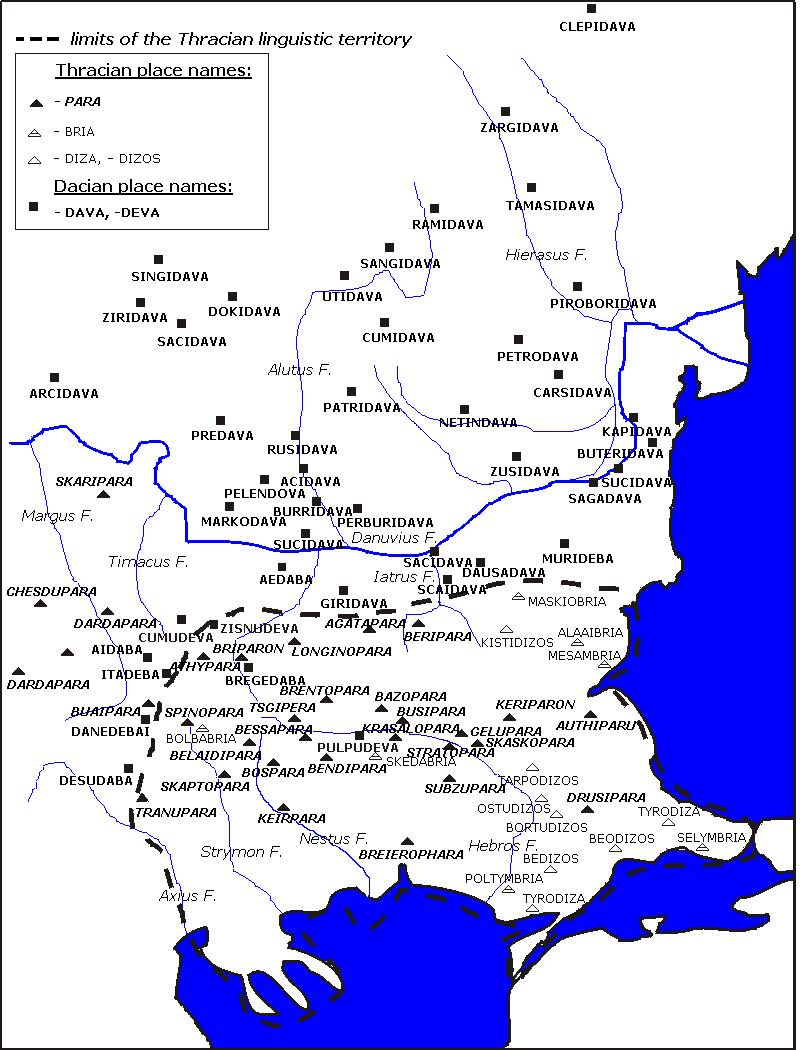VIII. The Thracian, Dacian and Paeonian languages
Many of the village names in ancient Thracia were composite, with the
words -para (-phara, -pera, -par![]() n,
etc.) ‘a village’, -bria ‘a town’ and -diza (-disza,
-dizos) ‘a fortress’ as a second element:
n,
etc.) ‘a village’, -bria ‘a town’ and -diza (-disza,
-dizos) ‘a fortress’ as a second element:
| Place names ending in -para (-phara,
-pera, -par |
Places names ending in -bria | Place names ending in -diza, -dizos |
| Agathapara | *Alaaibria | Bedizos |
| *Athypara | *Bolbabria | Beodizos |
| Authiparu | Maskiobria | Burtudizos |
| Bazopara | Mesambria | Kistidizos |
| Belaidipara | Poltymbria | Orudisza |
| Bendipara | Selymbri |
Ostudizos |
| Beripara (two times) | Skedabria | Tyrodiza (two times?) |
| Bessapara | ||
| Bospara | ||
| Breierophara | ||
| Brentopara | ||
| Briparo(n) | ||
| *Busipara | ||
| Chesdupara | ||
| Dardapara (two times) | ||
| Dodoparos | ||
| Drusipara | ||
| Gelupara | ||
| Isgipera | ||
| Keirpara | ||
| K |
||
| Krasalopara | ||
| Longinopara | ||
| Mutzipara | ||
| Priskupera | ||
| *Skaptopara | ||
| Spinopara | ||
| Stratopara | ||
| Subzupara | ||
| Tranupara | ||
|
|
|
|

Such names are not to be found in Dacia proper (on the northern side of the Danube), in Dobrudzha and most of Northern Bulgaria except its southern eras, where there were seven such names: Mitzipara, Longinopara, Agatapara, Beripara, Kistidizos, Maskiobria, *Alaaibria. The Dacian linguistic area is characterized with composite names ending in -dava (-deva, -daua, -daba, etc.) ‘a town’. The village names in -dava, -deva, are geographically grouped as follows:
1. In Dacia: Acidava, Argedauon, Burridava, Dokidaua, Karsidaua, Klepidaua, Komidaua, Markodaua, Netindaua, Patridaua, Pelendova, *Perburidava, Petrodaua, Piroboridaua, Rhamidaua, Rusidava, Sacidaba, Sangidaua, Setidaua, Singidaua, Sykidaba, Tamasidaua, Utidaua, Zargidaua, Ziridaua, Zucidaua – 26 names altogether.Besides these regions, similar village names are found in three other places:
2. In Lower Moesia (the present Northern Bulgaria) and Scythia minor (Dobrudzha): Aedabe, *Buteridava, *Giridava, Dausdavua, Kapidaua, Murideba, Sacidava, Scaidava (Skedeba), Sagadava, Sukidaua (Sucidava) – 10 names in total.
3. In Upper Moesia (the districts of Nish, Sofia, and partly Kjustendil): Aiadaba, Bregedaba, Danedebai, Desudaba, Itadeba, Kuimedaba, Zisnudeba – 7 names in total.
Thermi-daua (Ptol.), a town in Dalmatia. A Grecized form of *Germidava. This settlement was probably found by immigrants from Dacia.
Gil-doba – a village in Thracia, of unknown location.
Pulpu-deva (Iord.), Old-Bulg. Pl![]() p
p![]() dib
dib![]() (XII c. AD), Plodiv
(XII c. AD), Plodiv![]() (XI c. AD), known under the Greek name of Philippopolis (Liv.,
Plin., Ptol., etc.). The town was named after the conqueror Philip
II of Macedon (359-336 BC). It is improbable, however, that ‘Pulpudeva’
was imposed to the local inhabitants by the Macedons. Village names in
-deva are not found in Macedonia except Desu-daba in north eastern Macedonia,
somewhere around the town of Kochani. This village, however, is attested
late – by Livius. Most probably, it was founded by immigrants from Dacia
mediterranea, where such names (e.g. Aiadaba, Kuimedaba) were common. The
name of Pulpudeva must be explained as a translation of the Greek
Philippopolis
by the locals, who used -deba – a borrowed word from the north, from the
Moesian tribes of the present Northern Bulgaria. The Slavic Pl
(XI c. AD), known under the Greek name of Philippopolis (Liv.,
Plin., Ptol., etc.). The town was named after the conqueror Philip
II of Macedon (359-336 BC). It is improbable, however, that ‘Pulpudeva’
was imposed to the local inhabitants by the Macedons. Village names in
-deva are not found in Macedonia except Desu-daba in north eastern Macedonia,
somewhere around the town of Kochani. This village, however, is attested
late – by Livius. Most probably, it was founded by immigrants from Dacia
mediterranea, where such names (e.g. Aiadaba, Kuimedaba) were common. The
name of Pulpudeva must be explained as a translation of the Greek
Philippopolis
by the locals, who used -deba – a borrowed word from the north, from the
Moesian tribes of the present Northern Bulgaria. The Slavic Pl![]() p
p![]() dib
dib![]() ,
Plodiv
,
Plodiv![]() was derived from this Pulpudeva.
was derived from this Pulpudeva.
In any case names with -dava, -deva are exception in Thracia and cannot be regarded as proper Thracian. There is a clear geographical distinction between the place names ending in -para, -bria, and -dizos (the Thracian ones), from other side, from those ending in -dava, -deva (the Dacian ones) .
There is a number of other, phonetic differences between Dacian and
Thracian:
| Indo-European | Dacian | Thracian |
| b, d, g | b, d, g | p, t, k |
| p, t, k | p, t, k | ph, th, kh |
| ä (a) | ||
| e - after a consonant | e | |
| ai | a | ai |
| ei | e | ei |
| dt (tt) | s | st |
=> Thracian and Dacian were two different Indo-European languages.
. . .
The phonetic differences between Thracian and Paeonian are summarized
in the table below:
| Indo-European | Paeonian | Thracian |
| o | o | a |
| b, d, g | b, d, g | p, t, k |
| p, t, k | p, t, k | ph, th, kh |
| sn, zn | n(n) | (sn), zn |
[Previous] [Next]
[Back to Index]